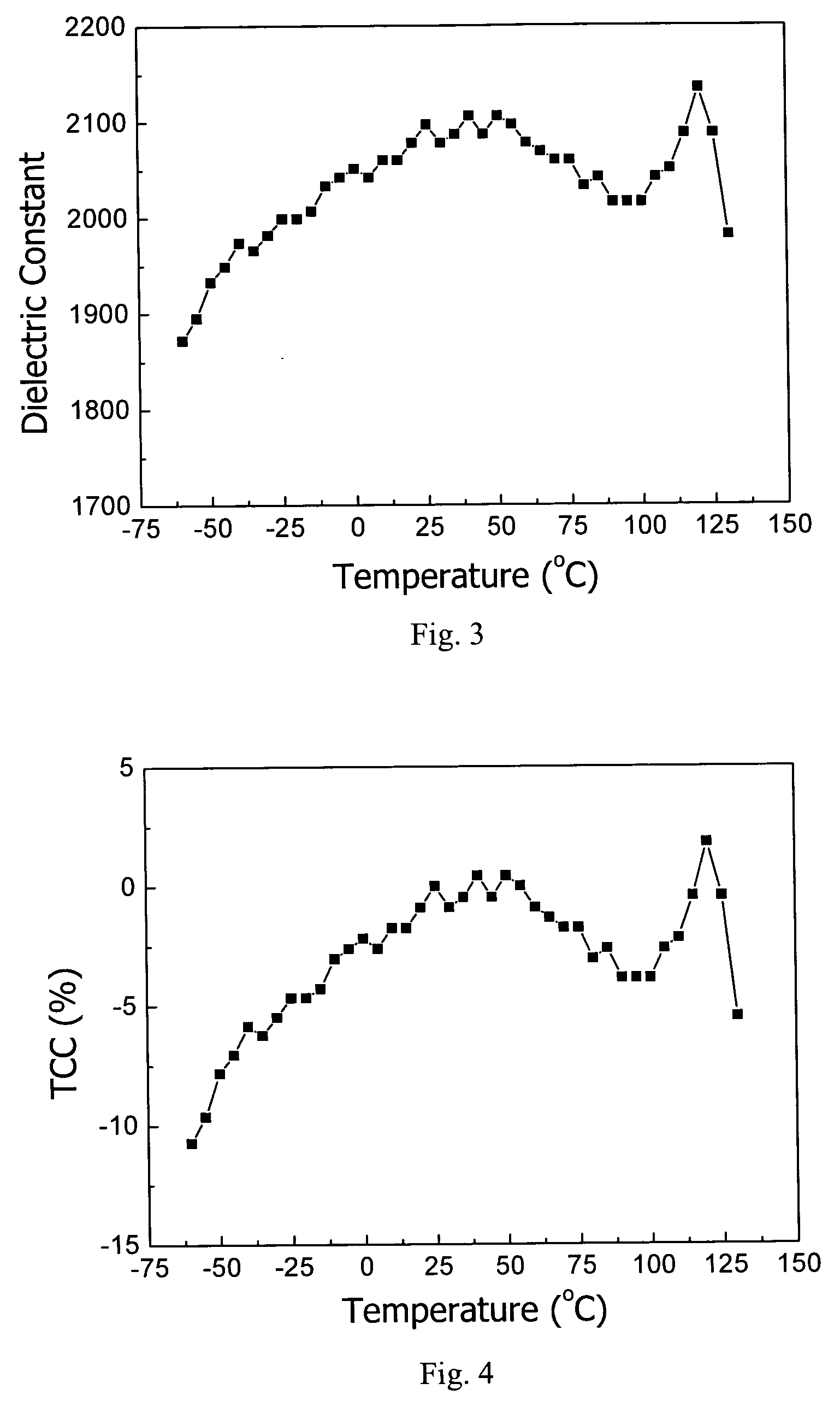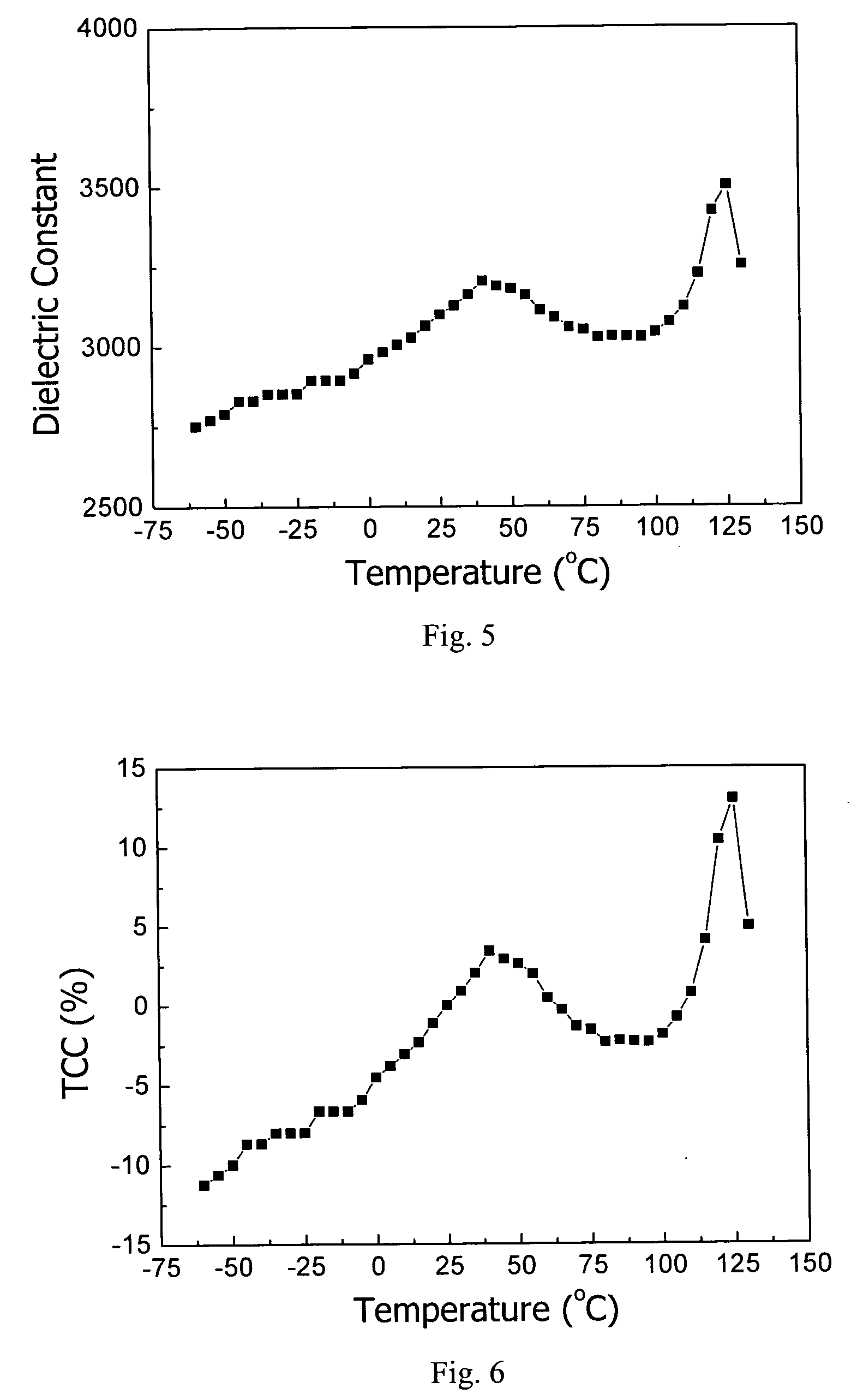Temperature-stable dielectric ceramic composition for multilayer ceramic capacitors with base-metal electrodes
a technology of dielectric ceramics and capacitors, which is applied in the direction of ceramics, fixed capacitors, electrical equipment, etc., can solve the problems of reducing the production cost of multilayer ceramic capacitors, oxidizing easily and loosening the function of internal electrodes, and dielectric ceramic compositions of no practical us
- Summary
- Abstract
- Description
- Claims
- Application Information
AI Technical Summary
Benefits of technology
Problems solved by technology
Method used
Image
Examples
example 1
[0036] Powders of 96 mol % BaTiO.sub.3 with an average grain size of 400 nm, 0.5 mol % CaTiO.sub.3, 0.3 mol % CaO, 0.8 mol % SiO.sub.2, 0.3 mol % SrO, 0.2 mol % MnO.sub.2, 0.2 mol % MgO, 0.2 mol % CO.sub.2O.sub.3, 0.5 mol % Y.sub.2O.sub.3, and 1.0 mol % Sm.sub.2O.sub.3 were mixed. Then 2 wt % (based on the total weight of the mixture) glass component (Ba.sub.ACa.sub.1-AO).sub.X.(Si.sub.BTi.sub.1-BO.sub.2) with A=0.4, B=0.9, x=1.1 was added. The mixture was ground for 15 hours by employing a wet method in a ball mill containing therein PSZ (Partially Stabilized Zirconia) balls, then dried at 110.degree. C. for 8 hours.
[0037] The mixture was then mixed with polyvinyl butyral as an organic binder and toluene to provide a ceramic slurry, which was then used for preparing green sheets having a thickness of 10 .mu.m by employing doctor blade method. Subsequently, a conductive paste having Ni powder as a main component was applied on the green sheets by using a print method to form interna...
example 2
[0038] Powders of 95.2 mol % BaTiO.sub.3 with an average grain size of 200 nm, 0.7 mol % CaTiO.sub.3, 0.4 mol % CaO, 0.8 mol % SiO.sub.2, 0.3 mol % SrO, 0.3 mol % MnO.sub.2, 0.3 mol % MgO, 0.2 mol % CO.sub.2O.sub.3, 0.8 mol % Y.sub.2O.sub.3, and 1.0 mol % Lu.sub.2O.sub.3 were mixed. Then 1.5 wt % (based on the total weight of the mixture) glass component (Ba.sub.ACa.sub.1-AO).sub.X.(Si.sub.BTi.sub.1-BO.sub.2) with A=0.5, B=0.8, x=1 were added. The mixture was ground for 20 hours by employing a wet method, and then dried at 100.degree. C. for 10 hours.
[0039] The mixture was then mixed with polyvinyl butyral and a toluene to provide a ceramic slurry, which was then used for preparing green sheets having a thickness of 8 .mu.m by employing doctor blade method. Subsequently, a conductive paste having Ni powder as a main component was applied on the green sheets by using a print method to form internal electrodes. Ten sheets of the ceramic green sheets having the internal electrodes ther...
example 3
[0040] Powders of 95 mol % BaTiO.sub.3 with an average grain size of 500 nm, 0.7 mol % CaTiO.sub.3, 0.4 mol % CaO, 0.7 mol % SiO.sub.2, 0.3 mol % SrO, 0.5 mol % MnO.sub.2, 0.4 mol % MgO, 0.2 mol % CO.sub.2O.sub.3, 0.7 mol % Y.sub.2O.sub.3, and 1.1 mol % Gd.sub.2O.sub.3 were mixed. Then 2.5 wt % (based on the total weight of the mixture) glass component (Ba.sub.ACa.sub.1-AO).sub.X.(Si.sub.BTi.sub.1-BO.sub.2) with A=0.5, B=0.9, x=1.1 were added. The mixture was ground for 20 hours by employing a wet method, and then dried at 110.degree. C. for 8 hours.
[0041] The mixture was then mixed with polyvinyl butyral and toluene to provide a ceramic slurry, which was then used for preparing green sheets having a thickness of 10 .mu.m by employing doctor blade method. Subsequently, a conductive paste having Ni powder as a main component was applied on the green sheets by using a print method to form internal electrodes. Ten sheets of the ceramic green sheets having the internal electrodes thereo...
PUM
| Property | Measurement | Unit |
|---|---|---|
| grain size | aaaaa | aaaaa |
| temperature | aaaaa | aaaaa |
| temperature | aaaaa | aaaaa |
Abstract
Description
Claims
Application Information
 Login to View More
Login to View More - R&D
- Intellectual Property
- Life Sciences
- Materials
- Tech Scout
- Unparalleled Data Quality
- Higher Quality Content
- 60% Fewer Hallucinations
Browse by: Latest US Patents, China's latest patents, Technical Efficacy Thesaurus, Application Domain, Technology Topic, Popular Technical Reports.
© 2025 PatSnap. All rights reserved.Legal|Privacy policy|Modern Slavery Act Transparency Statement|Sitemap|About US| Contact US: help@patsnap.com



